Pilot Saves A-10, Marvels At Damage
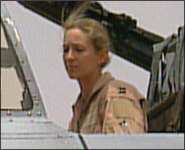 Her name is Capt. Kim Campbell (USAF), but you can
call her "KC." It stands for her call sign: Killer Chick. Friday,
in combat over Iraq, she faced the moment every pilot
dreads.
Her name is Capt. Kim Campbell (USAF), but you can
call her "KC." It stands for her call sign: Killer Chick. Friday,
in combat over Iraq, she faced the moment every pilot
dreads.
"I heard a loud bang and the jet rolled fairly violently to the
left, and I knew immediately that I had been hit," she said. "I
think the first thing was just trying to regain control of the
aircraft. [I] also thought that there was no way I wanted to eject
over Baghdad." Her plane had been strafed by anti-aircraft bullets.
It was on fire, its hydraulic system knocked out.
"Bino," her wing man and commander, flying his A-10 Warthog next
to hers, wondered whether K.C. should eject. "She had the option
[of bailing out] the whole time," he said. "She figured the plane
was flying well enough. She told me she could handle it. I got to
take her word for it. She is a good pilot."
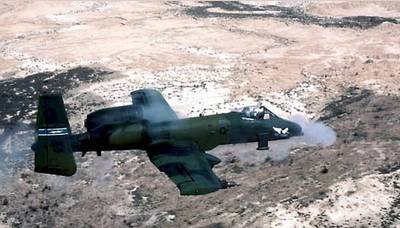
A Combat First
K.C. knew she would have to land the plane without hydraulic
assist, a maneuver A-10 pilots apparently don't train for.
"But I knew I was going to do it this time," K.C. said. Although
landing the A-10 manually without hydraulics requires great
physical strength, K.C. managed to nurse the jet back to her base
in Kuwait for a "perfect landing."
"Besides the engineers who did the first tests at the beginning
of the flight of the A-10, she is the only one who has ever landed
in the manual reversion mode that didn't destroy the airplane,"
said Bino, whose real name is Lt. Col. Rick Turner, the commander
of the 75th Squadron. The "Fighting Tigers" fly the Warthog.

Slow and Ugly
The Warthog, designed to knock out tanks from the sky, looks
like a plane only a mother could love — and, of course, the
pilots who fly it. "I'm willing to go to the battle with that,"
Bino said. "I know that if I get hit it's going to bring me
home."
He has faith even though the A-10 model was first produced in
1972 and has been flying since 1975. In other words, it may be old
and slow, but, "I'm old and slow, too," Bino said.
On today's high-tech battlefield, the Warthog is about as
low-tech as you can get: no fancy computers or guidance systems.
The A-10 is flown the old-fashioned way. "We have to put the
airplane in the right piece of sky, find that one point in the sky
where we can release the bomb, and have it hit the ground where we
want to," Bino said.
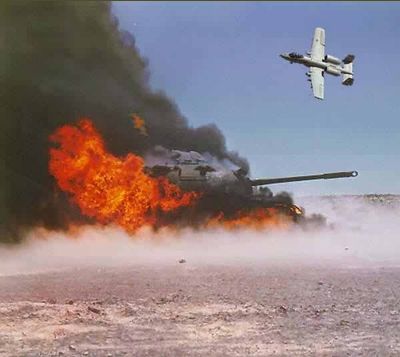
Smart Pilots, Not Smart Bombs
The bombs they drop are not "smart" bombs. Instead, Bino said,
they rely on "smart pilots" who not only have to fly this heavy
hunk of metal by themselves, but also aim and fire its bombs and
use the 30-mm gun in the plane's nose. "When you shoot the gun the
jet shakes," Bino said. "You smell the gunpowder burning."
Some of the pilots flying this deadly beast are not exactly who
you might expect — including captains K.C., and Danielle
Curley, otherwise known as Bash.
Bash said there's nothing like flying the Warthog. "There's a
lot of times where you feel like the jet is just an extension of
you," she said. "You know, you feel like you're strapping on the
jet and taking off, and you're one. She works with you. …
It's an awesome feeling. It's awesome."
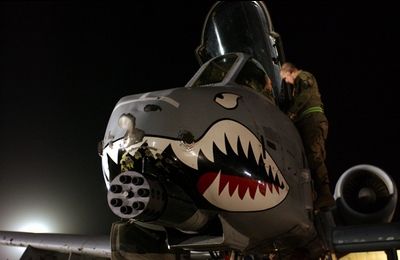
As American troops engage in deadly battles on the ground,
pilots like K.C. and Bash swoop down with their Warthogs and take
out Iraqi tanks, bunkers and trenches. The commander said he
worries every time his pilots take off. "You hate to associate it
to a family but it's like, you know, sending the kids off to school
and hoping they're going to do good today," he said. "I worry about
them."
‘Thank God for the Hog’
K.C. did not know exactly how much she had to worry about until
she got her Warthog home and realized it was practically a miracle.
The empennage of her warplane, built in 1981, looked like a cheese
grater, pockmarked with holes from Iraqi shrapnel. A large chunk
was ripped from the wing. "I was pretty amazed and very thankful,"
she said. "Just thank God for the hog. I couldn't ask to be flying
anything else" (file photo of KC's A-10 damage, below).
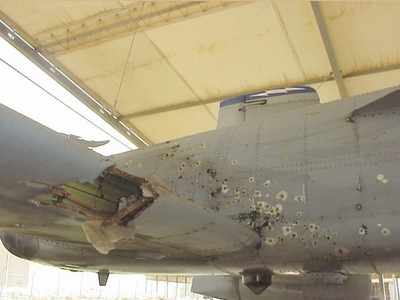
The very next day K.C. went back in the air, flying missions
over Iraq. "Our job is to help those guys on the ground," she said.
"And when they need it, we are going to be there, even if it means
taking some risks."

The rest of her squadron feels the same way. "I wouldn't pass
this up for the world," Bash said. "I love the mission. I love the
aircraft. I love to fly."
 Senator Pushes FAA to Accelerate Rocket Launch Licensing
Senator Pushes FAA to Accelerate Rocket Launch Licensing Classic Aero-TV: RJ Gritter - Part of Aviations Bright New Future
Classic Aero-TV: RJ Gritter - Part of Aviations Bright New Future Aero-FAQ: Dave Juwel's Aviation Marketing Stories -- ITBOA BNITBOB
Aero-FAQ: Dave Juwel's Aviation Marketing Stories -- ITBOA BNITBOB ANN's Daily Aero-Linx (10.27.24)
ANN's Daily Aero-Linx (10.27.24) ANN's Daily Aero-Term (10.27.24): Clearance Void If Not Off By (Time)
ANN's Daily Aero-Term (10.27.24): Clearance Void If Not Off By (Time)









